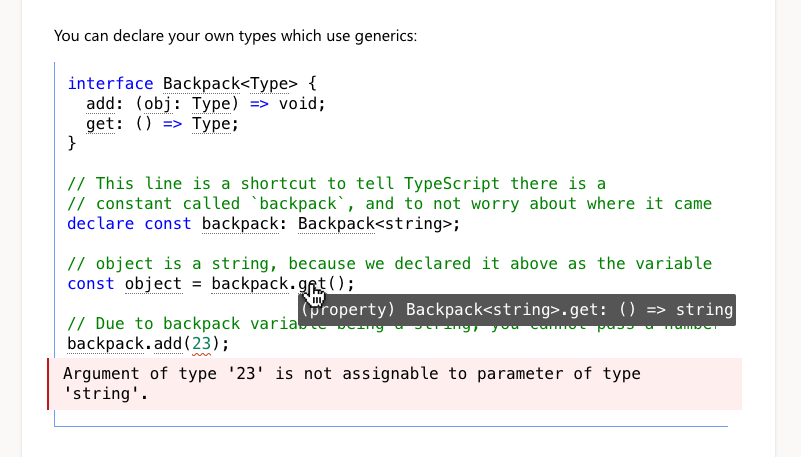
Security News
JavaScript Leaders Demand Oracle Release the JavaScript Trademark
In an open letter, JavaScript community leaders urge Oracle to give up the JavaScript trademark, arguing that it has been effectively abandoned through nonuse.
remark-shiki-twoslash
Advanced tools
Sets up markdown code blocks to run through shiki which means it gets the VS Code quality syntax highlighting. This code is basically the same as gatsby-remark-shiki-twoslash.
Why Shiki? Shiki uses the same syntax highlighter engine as VS Code, which means no matter how complex your code is - it will syntax highlight correctly.
In addition to all the languages shiki handles (it's a lot), this module adds opt-in @typescript/twoslash rendering for TypeScript code blocks and tsconfig JSON files.
This module powers the code samples on the TypeScript website.

With a bit of work, you can explain complicated code in a way that lets people introspect at their own pace.
Install the dependency: yarn add remark-shiki-twoslash
Include "gatsby-remark-shiki-twoslash" in the plugins section of whatever you're using:
const jsx = await mdx(content, {
filepath: "file/path/file.mdx",
- remarkPlugins: [],
+ remarkPlugins: [[remarkShikiTwoslash, { theme: "dark_vs" }]],
}
}
Add the CSS
This CSS comes from the TypeScript website's scss
You should consider it a base to work from, rather than a perfect for every project reference.
/* Code blocks look like:
<pre class='shiki twoslash'>
<div class='language-id>[lang-id]</div>
<div class='code-container'>
<code>[the code as a series of spans]</code>
</div>
</pre>
*/
pre {
/* In theory shiki will overwrite these, but this is to make sure there are defaults */
background-color: white;
color: black;
/* Give it some space to breathe */
padding: 12px;
/* All code samples get a grey border, twoslash ones get a different color */
border-left: 1px solid #999;
border-bottom: 1px solid #999;
margin-bottom: 3rem;
/* Important to allow the code to move horizontally; */
overflow: auto;
position: relative;
}
pre.shiki {
overflow: initial;
}
/* So that folks know you can highlight */
pre.twoslash {
border-color: #719af4;
}
/* The code inside should scroll, but the overflow can't be on the shiki because it would not allow the relative positioning */
pre .code-container {
overflow: auto;
}
/* Handle scrolling, and showing code correctly */
pre code {
white-space: pre;
-webkit-overflow-scrolling: touch;
}
/* Let errors use the outer shiki for their absolute sizing, and not be affected by the scrolling of the code */
pre data-err {
background: url("data:image/svg+xml,%3Csvg%20xmlns%3D'http%3A%2F%2Fwww.w3.org%2F2000%2Fsvg'%20viewBox%3D'0%200%206%203'%20enable-background%3D'new%200%200%206%203'%20height%3D'3'%20width%3D'6'%3E%3Cg%20fill%3D'%23c94824'%3E%3Cpolygon%20points%3D'5.5%2C0%202.5%2C3%201.1%2C3%204.1%2C0'%2F%3E%3Cpolygon%20points%3D'4%2C0%206%2C2%206%2C0.6%205.4%2C0'%2F%3E%3Cpolygon%20points%3D'0%2C2%201%2C3%202.4%2C3%200%2C0.6'%2F%3E%3C%2Fg%3E%3C%2Fsvg%3E")
repeat-x bottom left;
padding-bottom: 3px;
}
/* In order to have the 'popped out' style design and to not break the layout
/* we need to place a fake and un-selectable copy of the error which _isn't_ broken out
/* behind the actual error message.
/* This section keeps both of those in sync */
pre .error,
pre .error-behind {
margin-left: -20px;
margin-top: 8px;
margin-bottom: 4px;
padding: 6px;
padding-left: 14px;
white-space: pre-wrap;
display: block;
}
pre .error {
position: absolute;
background-color: #ffeeee;
border-left: 2px solid #bf1818;
width: calc(100% - 14px);
/* Give the space to the error code */
display: flex;
align-items: center;
color: black;
}
pre .error .code {
display: none;
}
pre .error-behind {
user-select: none;
color: #ffeeee;
}
data-lsp {
/* Ensures there's no 1px jump when the hover happens above */
border-bottom: 1px dotted transparent;
/* Fades in unobtrusively */
transition-timing-function: ease;
transition: border-color 0.3s;
}
/* Respect people's wishes to not have animations */
@media (prefers-reduced-motion: reduce) {
data-lsp {
transition: none;
}
}
/** When you mouse over the pre, show the underlines */
pre:hover data-lsp {
border-color: #747474;
}
/** The tooltip-like which provides the LSP response */
#twoslash-mouse-hover-info {
background-color: #3f3f3f;
color: #fff;
text-align: left;
padding: 5px 8px;
border-radius: 2px;
font-family: "JetBrains Mono", Menlo, Monaco, Consolas, Courier New, monospace;
font-size: 14px;
white-space: pre-wrap;
}
Add the JS for hover info to your component:
In a React codebase:
import React, { useEffect } from "react"
import { setupTwoslashHovers } from "shiki-twoslash/dom";
export default () => {
// Add a the hovers
useEffect(setupTwoslashHovers, [])
// Normal JSX for your component
return </>
}
In a non-React codebase, you can still call setupTwoslashHovers via a bundler or module import, it will set up all
of the hovers on the page, this will need to be after the HTML is set up.
With that set up, start up your server and add a codeblock to a markdown file to see if it renders with highlights:
```json
{ "json": true }
```
If that works, then add a twoslash example:
```ts twoslash
interface IdLabel {id: number, /* some fields */ }
interface NameLabel {name: string, /* other fields */ }
type NameOrId<T extends number | string> = T extends number ? IdLabel : NameLabel;
// This comment should not be included
// ---cut---
function createLabel<T extends number | string>(idOrName: T): NameOrId<T> {
throw "unimplemented"
}
let a = createLabel("typescript");
```
If the code sample shows as
function createLabel<T extends number | string>(idOrName: T): NameOrId<T> {
throw "unimplemented"
}
let a = createLabel("typescript")
Then it worked, and you should be able to hover over createLabel to see it's types.
This plugin passes the config options directly to Shiki and Twoslash. You probably will want to
set theme, then also the TwoslashOptions here.
FAQs
A remark plugin which renders code samples for all languages via Shiki, but has some real cool features for TS/JS code
The npm package remark-shiki-twoslash receives a total of 1,439 weekly downloads. As such, remark-shiki-twoslash popularity was classified as popular.
We found that remark-shiki-twoslash demonstrated a not healthy version release cadence and project activity because the last version was released a year ago. It has 3 open source maintainers collaborating on the project.
Did you know?

Socket for GitHub automatically highlights issues in each pull request and monitors the health of all your open source dependencies. Discover the contents of your packages and block harmful activity before you install or update your dependencies.

Security News
In an open letter, JavaScript community leaders urge Oracle to give up the JavaScript trademark, arguing that it has been effectively abandoned through nonuse.

Security News
The initial version of the Socket Python SDK is now on PyPI, enabling developers to more easily interact with the Socket REST API in Python projects.

Security News
Floating dependency ranges in npm can introduce instability and security risks into your project by allowing unverified or incompatible versions to be installed automatically, leading to unpredictable behavior and potential conflicts.